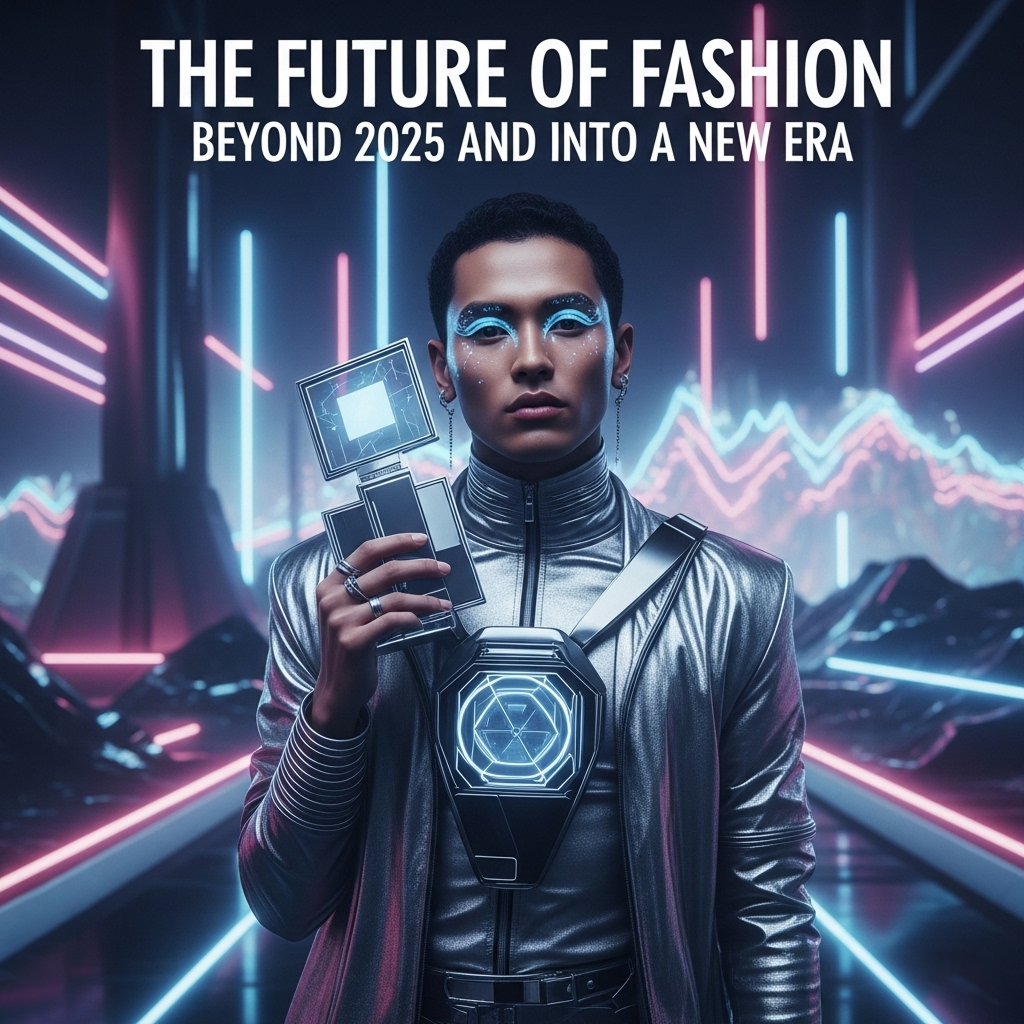Blog
The Future of Fashion: Beyond 2025 and Into a New Era

The fashion industry stands at a pivotal juncture. The relentless churn of fast fashion, the environmental crisis, and evolving consumer values are forcing a radical re-evaluation of its very foundations. Looking beyond 2025, the future of fashion isn’t merely about new trends; it’s about a fundamental shift in how clothes are designed, produced, consumed, and experienced. This new era will be defined by an unprecedented fusion of technology and sustainability, a deeper commitment to inclusivity, and a reimagining of our relationship with our wardrobes.
Hyper-Personalization: Fashion Tailored Just for You
Mass production, a hallmark of 20th-century fashion, is slowly giving way to an era of extreme hyper-personalization. Advances in technology will make truly bespoke fashion accessible to the masses.
AI-Driven Custom Design: Imagine a future where AI analyzes your body shape (from a simple phone scan), your personal style preferences, your lifestyle, and even your mood, then designs garments specifically for you. These designs could then be 3D printed or manufactured on-demand with minimal waste. Virtual stylists, powered by AI, will provide highly curated recommendations that go beyond simple algorithms.
Made-to-Measure on Demand: The return to made-to-measure will be democratized. Instead of just bespoke tailoring for the wealthy, digital tools and advanced manufacturing will allow anyone to order clothes that perfectly fit their unique dimensions, reducing alterations and increasing comfort.
Adaptive Fashion: Beyond size, fashion will become more adaptable to individual needs, whether it’s for people with disabilities, specific professional requirements, or even fluctuating body types.
Circular Fashion and Regeneration: From Waste to Resource
The linear “take-make-dispose” model of fashion is unsustainable. The future demands a radical embrace of circularity and regeneration, moving beyond simply “less bad” to actively “doing good” for the planet.
Closed-Loop Systems: Expect to see widespread adoption of manufacturing processes where materials are endlessly recycled back into new fibers without degradation. Innovations in textile recycling, particularly for mixed-fiber garments, will become mainstream.
Regenerative Agriculture: The focus will shift to sourcing materials from regenerative farms that improve soil health, sequester carbon, and enhance biodiversity, turning textile production into an ecological benefit rather than a burden.
Product-as-a-Service: The rise of rental and subscription models for everyday wear, not just special occasions, will become common. This prioritizes access over ownership, extending garment life and reducing individual consumption.
Repair and Longevity: Brands will heavily invest in robust repair services, design for durability, and educate consumers on garment care, actively encouraging consumers to cherish and extend the life of their clothes. The concept of “fast fashion” will be culturally rejected, replaced by a reverence for longevity and craftsmanship.
Digital Fashion and the Metaverse: Blurring Realities
The burgeoning metaverse will create entirely new frontiers for fashion, blurring the lines between physical and virtual realities.
Virtual Wardrobes for Avatars: Digital clothing for avatars will become a significant market. People will invest in virtual outfits to express their identity in online spaces, from gaming worlds to virtual meetings.
NFTs as Fashion Assets: Non-Fungible Tokens (NFTs) will allow for verifiable ownership and scarcity of digital garments, creating a unique economy for virtual fashion. Designers will launch digital-only collections that exist purely in the metaverse.
Phygital Experiences: The physical and digital worlds will merge. Brands will create “phygital” products – physical garments that come with a digital twin for your avatar, or virtual clothing that can be “worn” in AR over your real-world self. Virtual fashion shows will be the norm, offering immersive experiences accessible globally.
Democratized Design: New digital tools will empower a broader range of creators to design and monetize digital fashion, fostering a more diverse and inclusive design landscape.
Gender Fluidity and Inclusivity: A Truly Diverse Canvas
Traditional gender norms in fashion have been steadily eroding, and this trend will accelerate, leading to a truly gender-fluid and inclusive fashion landscape.
Unisex and Gender-Neutral Collections: More brands will design collections that are not categorized by gender, focusing instead on silhouettes, fabrics, and aesthetics that appeal to diverse bodies and personal expressions.
Body Positivity and Size Inclusivity: The industry will move beyond tokenism, genuinely representing and designing for all body types, ages, abilities, and ethnicities across all campaigns, runways, and retail offerings. Adaptive clothing, designed with specific needs in mind, will become a standard offering.
Cultural Appreciation, Not Appropriation: There will be a heightened awareness and respect for cultural influences, ensuring that inspiration is drawn respectfully and designers acknowledge their sources.
Biotechnology and Advanced Materials: The Science of Style
Innovation in material science will revolutionize what clothes are made of and how they perform.
Lab-Grown Materials: Expect widespread adoption of materials grown in labs, such as synthetic spider silk (stronger and lighter than natural silk), mushroom leather (Mylo), and bio-fabricated fabrics from algae or bacteria. These eliminate the need for traditional resource-intensive agriculture or animal farming.
Self-Cleaning and Smart Fabrics: Fabrics will become inherently smarter. Self-cleaning textiles will reduce the need for washing (and water use), while materials with integrated climate control will automatically regulate temperature based on the wearer’s body and environment.
Carbon-Negative Materials: Research will focus on materials that not only have a low environmental impact but actively remove carbon from the atmosphere during their production.
Enhanced Recyclability: New molecular recycling technologies will break down complex textile blends into their base components, allowing for higher-quality recycling that can truly close the loop.
Local Production and On-Demand Manufacturing: The Hyper-Local Loom
The globalized supply chain, while efficient in some ways, is vulnerable and environmentally costly. The future will see a rise in localized, on-demand production.
Micro-Factories and Automation: Smaller, highly automated “micro-factories” located closer to consumer markets will reduce transportation emissions, shorten lead times, and allow for rapid response to demand.
Hyper-Localized Craftsmanship: A resurgence of local artisans and small-scale production, leveraging both traditional skills and modern technology (like 3D printing), will create unique, high-quality pieces with strong provenance.
Reduced Overproduction: Producing garments only when an order is placed will virtually eliminate unsold inventory, a major source of waste in the current system.
The Experience Economy: Beyond Just Buying Clothes
Shopping for fashion will evolve from a transactional activity into an immersive experience.
Retail as Entertainment Hubs: Physical stores will transform into interactive spaces, offering workshops, personalized styling sessions, virtual try-on experiences, and community events, becoming destinations rather than just points of sale.
Subscription Boxes and Curated Services: AI-powered subscription boxes will deliver highly curated selections of clothing directly to consumers, catering to their evolving tastes and reducing decision fatigue.
Gamified Shopping: Elements of gaming will be integrated into the shopping experience, from virtual rewards to interactive challenges that engage consumers more deeply with brands.
Conclusion: A Conscious and Creative Future
The future of fashion is undeniably complex, but it is also brimming with potential. It’s a future where innovation is driven not just by aesthetic desire but by a profound commitment to sustainability and social equity. Clothes will be smarter, production will be cleaner, and the boundaries between physical and digital self-expression will dissolve.
This new era will require a fundamental shift in mindset from both the industry and consumers. It means valuing quality over quantity, creativity over conformity, and ethical production over cheap thrills. As we move beyond 2025, fashion will remain a powerful form of self-expression and cultural reflection, but it will do so with a newfound consciousness, embracing a future that is as innovative as it is responsible, and as diverse as humanity itself.
